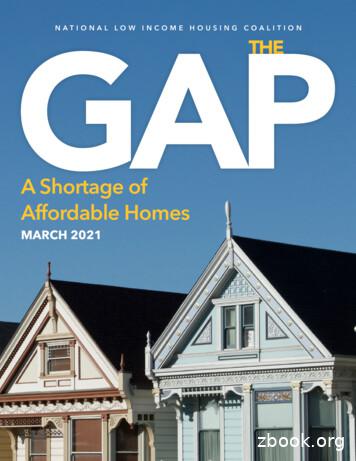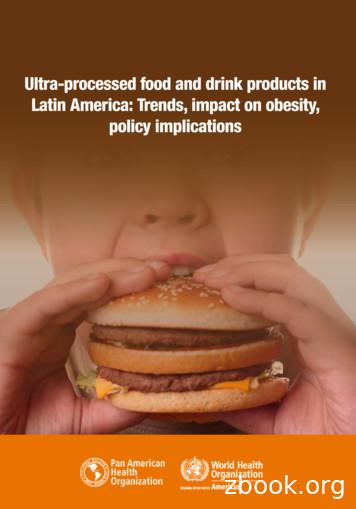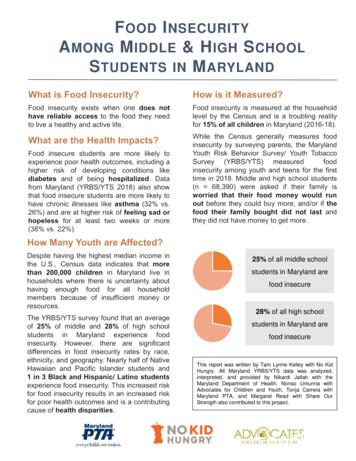Lower-middle Income Countries: Study Results On Adoption .
Lower-middle income countries:study results on adoption andfinancing of new vaccinesSAGENovember r
Organization of presentationBackgroundWhy LMIC new vaccine adoption?Study TORsMethods: country case studies, key informantinterviews, quantitative analyses Limitations Findings from country cases, industry interviews, andquantitative work Summary of what is new
BackgroundWHO/GatesLMICNewVaccineAdop9onStudy Overseen by Bill and Melinda Gates Foundation and WHO Advisory Group provided guidance and support Study implemented by Results for Development Institute (R4D),Washington, DC Began in November 2009, nearing completion
StudyAdvisoryGroup AGinaTambini,PAHO
LMICs World Bank definition: 2008 GNI/capita 976 - 3,855Population 3.8 billion (1.4 billion excluding China and India)Birth cohort 76 million (33 million excluding China and India)Unlike LICs, most do not receive GAVI funding2008 LMIC, GAVI ineligible2008 LMIC, graduating from GAVI in 20112008 LMIC, will remain GAVI eligible
LMIC Hib %)12(22%)Birthcohort(millions)22(29%)54(71%)2008 LMIC, Adopted Hib2008 LMIC, Yet to adopt HibSource: WHO Immunization surveillance, assessment and monitoring. Reported immunization schedules by vaccine [Internet]. Geneva: WHO; [updated 2010 Oct 11; cited 2010 Nov 8].Available from http://apps.who.int/immunization monitoring/en/globalsummary/scheduleselect.cfm
LIC Hib %)4(11%)Birthcohort(millions)29(81%)7(19%)2008 LIC, Adopted Hib2008 LIC, Yet to adopt HibSource: WHO Immunization surveillance, assessment and monitoring. Reported immunization schedules by vaccine [Internet]. Geneva: WHO; [updated 2010 Oct 11; cited 2010 Nov 8].Available from http://apps.who.int/immunization monitoring/en/globalsummary/scheduleselect.cfm
Hib adoption: comparing LICs and 22%)54(71%)
NIP performance in LMICsNumberofcountries302520271512105970 90%80- ‐89%70- ‐79% 70%
TermsofReferencePurpose: ndopDonsforaddressingconstraintsObjecDves: MICdemandFocuses: upport Vaccines:Hib,Pneumo,Rota,andHPV
nsfromselectedUMICsMixofadopters/non- Dallist,replacedbyIndonesia
Data collectionIn-Depth LMIC Country StudyIn-Depth UMIC Country StudyRemote LMIC Country StudyCountryStudiesRemote UMIC Country ape VerdeThailandPanamaSyriaEcuadorIndonesiaSouth AfricaPhilippines
Countrycasestudies Interviewswith5- inesuppliersLessons,suggesDons
Data collectionExpertConsulta9ons Immunization program experts (20)Vaccine manufacturers (10 total: 5 IFPMA, 5 DCVMN)Regional Working Group membersProcurement agencies (UNICEF, PAHO)
Dataanalysis Kaplan- romDmeofavailability– Samples:UMICs,LMICs,andLICs Coxsurvivalmodelregressions– Dependentvariables:Dmefromavailabilityofpre- ‐qualifiedHibandHepBvaccinetoadopDon– toaffectdecisions– Samples:LICs MICs;MICsonly
LimitaDons MuchofinformaDoncollectedandanalyzedisobservaDonal SelecDonofcountriesnon- ‐random,ratheritwasdeliberate tmeasurable AccesslimitedtosomesensiDvedata
Status of studyCompletecomponents All country case studies, manufacturer interviews,and global vaccine expert interviews Third draft report on country and global expertinterviews following AG input Draft section on findings from manufacturers Draft quantitative analysis Session on preliminary results at NUVI in June
Status of studyComponentstobecompleted Report to SAGE (November 11, 2010) Integration of manufacturer interview results andquantitative analysis with country and global expertinformation Analysis of impact of projected faster adoption onvaccine markets
udgetforvaccinesEpidemiologyCost- ‐effec9venessCost- XXXX14XXXXXX5XXXXX423X6X7333X3
Summary of findingsLMICvaccinedecision- ‐makingisdeliberateandra9onalGrouping of factors in country decision making: Factors important in the majority of countriesFactors important in multiple countriesOther factors mentioned by countriesHypothesized factors of small importance
Summary cinesCost- ‐effec9venessPrice02468101214
Summary commenda9onBudgetforvaccinesCost- ‐effec9venessPrice02468101214
Summary of ntbyReg/GlobOrgs02468101214
Summary of PStrengthPrivatemarkets02468101214
Summary of tries Vaccine characteristics Media
Summary of findingsIndustryperspec9ve LMICs important—but LMICs not seen as a single market No capacity constraint to meeting demand from LMICsoutside India and China (latter are special cases) IFPMA members appreciate UNICEF SD for forecasting,multi-year contracts, standard requirements DCVMN members want more tech transfers Wish to preserve ability to pursue company pricingstrategies (for IFPMA members “tiered pricing”)
Summary of findingsIndustryperspec9ve Pools provide advantages to industry – simplifymarketing, standardize products, allow large volumes DCVMN members feel disadvantaged by some LMICregulatory practices and lack of presence DCVMN members mainly focused on domestic markets,but working to enter MIC and HIC markets Believe budget availability, political commitment, andprogram performance more important than price incountry adoption decisions – worry about GAVI grads
Summary of findingsQuan9ta9veanalysisresultsKaplan-Meier survival functions Hep B UMICs and LMICs adopted at statistically similar rates,significantly faster than LICs LICs began to catch up following start of GAVI Hib UMICs adopted faster than LMICs and LICs that adopted atstatistically similar rates
Summary of findingsQuan9ta9veanalysisCox survival model regression analysis of years toadoption of Hep B and Hib vaccines Measurable independent variables: Income, NIP strength, region, govt health spending, govtimmunization spending, line-item, BOD evidence, Hep Band meningitis BOD, neighbors’ adoption Analyses conducted for: (1) MICs and (2) LICs and MICstogether
Summary of findingsQuan9ta9veanalysisresultsSignificant positive associations with vaccine adoptionin multiple analyses: Adoption by neighbors (HepB across income groups) Strength of NIP (LMICs/LICs across vaccines) AMR countries (Hib across income groups)Significant positive associations in only one analysis: Income levelLine-item for immunizationsWPR countriesEMR countries
Sowhatisnew?1. Costandprice- lueformoneyandsustainability2. �tinvestmuchingatheringhigh- ‐qualitydata.ThereisliMletonointer- ‐countrycooperaDonorcollaboraDon3. ementofcompeDDon4. mentopDons,andmarketdynamics
Sowhatisnew?4. inedecisiontakenatNIPDirectorlevel5. oinfluencedecisions6. �nancing,eventhoughotherpeerLMICsaredoingso7. Noone- ‐size- ‐fits- ‐allapproachpossibleforthisdiversesetofcountries
Thankyou.QuesDons?
LMIC GAVI eligibility in 20112008 LMIC, GAVI ineligible2008 LMIC, GAVI eligible
LIC LMIC Hib 22%)54LIC34(89%)4(11%)382008 LMIC, Adopted Hib2008 LIC, Adopted Hib2008 LMIC, Yet to adopt Hib2008 LIC, Yet to adopt HibSource: WHO Immunization surveillance, assessment and monitoring. Reported immunization schedules by vaccine [Internet]. Geneva: WHO; [updated 2010 Oct 11; cited 2010 Nov 8].Available from http://apps.who.int/immunization monitoring/en/globalsummary/scheduleselect.cfm
Advisory Group involvement Advice on methodsInput into selection of countriesIdentification of key informantsProviding documents, data, and introductionsTracking progress (monthly phone calls, NUVI faceto-face)Assisting with decision making along the wayReview and comment on draft reportsAssistance with prioritizing recommendations
BackgroundRelevancetoSAGENovember 2008 SAGE:“WHO conduct further situation analysis of financialchallenges for low and middle-income countries andconsultation with countries concerned & partners to distilissues to more actionable activities”.2008 WHA requested the DG:“To collaborate with international partners, donors as wellas vaccine producers to mobilize necessary resources tosupport low income and middle income countries with theaim of increasing supply of affordable vaccines of assuredquality”.
Tunisia Syria Armenia Albania Remote LMIC Country Study In-Depth LMIC Country Study In-Depth UMIC Country Study Remote UMIC Country Study . Country&case&studies& Interviews&with&5V10&key&informants& Vaccine&adopDon&decision&making& Regulatory&system& Financial&allocaDons& External&support
Income Tax Act 2007 2007 No 97 BC 6 Income tax liability of filing taxpayer 106 BC 7 Income tax liability of person with schedular income 106 BC 8 Satisfaction of income tax liability 108 Subpart BD—Income, deductions, and timing BD 1 Income, exempt income, excluded income, non- 108 residents' foreign-sourced income, and assessable income
The globe at a glance: 3 High-income countries treat about 70% of the wastewater they generate, while that ratio drops Upper middle-income countries about 38% Lower middle-income countries 28% Low-income countries, only 8% of industrial and municipal wastewater undergoes treatment of any kind (Sato et al., 2013). The AQUASTAT database of FAO estimates global freshwater .
AREA MEDIAN INCOME (AMI): The median family income in the metropolitan or nonmetropolitan area EXTREMELY LOW-INCOME (ELI): Households with income at or below the Poverty Guideline or 30% of AMI, whichever is higher VERY LOW-INCOME (VLI): Households with income between ELI and 50% of AMI LOW-INCOME (LI): Households with incomes between 51% and .
Africa remains the most unequal of the seven countries. Income redistribution tends to be higher in more unequal countries to start with: redistribution is considerable higher in countries with higher market income inequality such as South Africa and Brazil than in countries with relatively lowe
middle-and low-income countries (9). The most striking change in food systems of high-income countries, and now of low- and middle-income countries, is displacement of dietary patterns based on meals and dishes prepared from unprocessed or minimally processed foods by those that are increasingly based on ultra-processed
Children with cancer in low- and middle-income countries are four times more likely to die of the disease than those in high income countries (World Health Organization, 2018). In Ghana, a lower-middle-income West African country of 35 million people, approximately 1300 children are diagnosed with cancer annually and many die undiagnosed.
Stemmers Run Middle White Oak School Windsor Mill Middle Woodlawn Middle Caroline Col Richardson Middle Carroll Crossroads Middle Cecil Elkton Middle Charles General Smallwood Middle R.D. Stethem Ed Center Dorchester All schools are enrolled in CEP! Harford Center for Ed Opportunity Alt
031901043 faulk middle: sw 96.54%: 031901044 stell middle: sw 95.70%: 031901045 oliveira middle: sw 94.80%: 031901046 perkins middle: sw 97.41%: 031901047 vela middle: . a p solis middle sw 88.35% 108902046; veteransmiddle sw 92.36% 108902047; dora m sauceda middle sw 97.34% 108902048; w a todd middle sw 93.21% 108902102;























